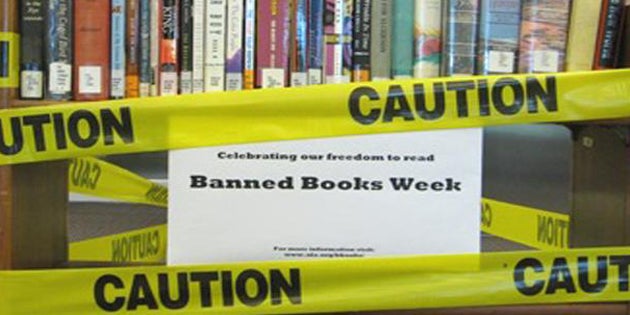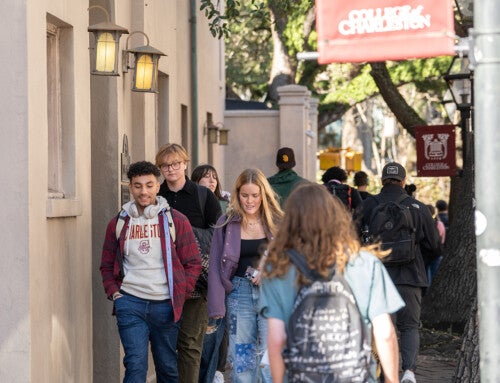What if there was no Harry Potter or Tom Sawyer?
 What if you never knew that Atticus Finch said, “It’s a sin to kill a mockingbird.”
What if you never knew that Atticus Finch said, “It’s a sin to kill a mockingbird.”
What if you were unaware that Holden Caulfield said “It’s really too bad that so much crumby stuff is a lot of fun sometimes.”
These are just a few characters that were silenced at one time after being banned from schools and public libraries in the United States.
In recognition of National Banned Book Week, the College of Charleston is planning several events celebrating the freedom to read. Events range from writers and artists reading from their favorite banned books during an event in the Halsey Institute of Contemporary Art to a “Do-It-Yourself“ festival on Rivers Green that celebrates the free expression of ideas.
RELATED: Find out more about College of Charleston “National Banned Book Week.“
Stumped on deciding which banned book to pick up and read this week?
Several College of Charleston English professors have recommendations for you.
All of these recommended books have made both the “challenged/banned list” and the “Top 100 novels of the 20th century” list:
Recommended by Bret Lott
The Grapes of Wrath‘s depiction — in all its grit and angst and sorrow — of an America at its lowest ebb is an incredibly important and timeless one because it shows us who we were, are, and can be, when faced with the meanest and most cruel of circumstances. Nowhere penned, to my way of thinking, is a more poignant and more powerful line about the influence a good man can have on another, and the spirit that cannot be extinguished even by death when justice is the motive behind one’s actions, than when Tom Joad, trying to allay Ma’s concerns about his safety in the worker’s movement after Casy’s death, says this: “Wherever they’s a fight so hungry people can eat, I’ll be there. Wherever they’s a cop beatin’ up a guy, I’ll be there. If Casy knowed, why, I’ll be in the way guys yell when they’re mad an’—I’ll be in the way kids laugh when they’re hungry n’ they know supper’s ready. An’ when our folks eat the stuff they raise an’ live in the houses they build—why, I’ll be there.” It seems the preponderance of reasons for its having been challenged of late has to do with the perceived vulgarity of the way the poor are portrayed, and the book’s profane language; the same old reasons. Yet the book to this day holds up as one of the greatest —and most harrowing, and most inspiring — stories in American history. We need to keep reading this book, and reading it, and reading it, to remember where we’re been, and to see who we can be.
Recommended by Julie Eichelberger
This novel is set in a small town in 1930s Alabama and is narrated by a very young Scout, a girl whose father, Atticus Finch is the white defense attorney for an African American man who has been unjustly charged with rape. My parents encouraged me to read this book when I was much too young to understand most of the dangers the characters were learning about, but I wasn’t too young to appreciate a story of a family holding onto its values despite the disapproval of many in their community. The rape trial and other topics treated in the novel‹domestic violence, abuse of adults with disabilities, drug addiction, extreme poverty, a criminal justice system that discriminates against people of color are disturbing, but they are as prevalent today as they were when this book was published. The children in Lee’s novel are saddened and confused by the realities they encounter, but the adults who look out for them, their father, their housekeeper, Calpurnia, and eventually their neighbor, Boo Radley, are models of courage and generosity.
As a work of literature, the novel vividly captures the speech and customs of a small Southern town. Its portrait of a 1930s Southern community is also a comment on the civil rights movement that was underway when the novel was published in 1960. Scout is something of a 20th-century Huck Finn, an ingénue who doesn¹t understand everything she sees but who already knows that some of it is bogus. Her character is a refreshing alternative to traditional conceptions of Southern female identity.
Recommended by Conseula Francis
The Color Purple is an incredibly satisfying story about a community of women who survive, against considerable odds, because they matter too each other. They decide to save each others lives and they succeed. Far from a story we need protection from, this novel is a nice reminder of the healing power of community.
Recommended by Joe Kelly
A U.S. District Court lifted the ban on James Joyce’s Ulysses just about the same time Congress abandoned Prohibition. Somewhat tongue-in-cheek, the publisher’s lawyer, Morris Ernst, suggested that the Court’s decision would eventually prove more important than Congress’. He might have been right. Joyce’s book was banned because it happened to expose a wealthy New York lawyer’s teenaged daughter to sexual content. The United States v. One Book Called Ulysses was an important battle in a cultural war still being fought today. To what extent can government criminalize sex? Today, nineteen out of every twenty Americans have had sex outside of marriage–without fear of government retribution. All but the one owe a debt to Ulysses.
Recommended by Scott Peeples
In my first real job, teaching high school English, I would read The Catcher in the Rye to my freshman class whenever we had a few minutes at the end of the period. It was one of the few things I did right – they loved the book, loved hearing such a distinctive voice that, even though it came from the 1950s, sounded so much like their own. That’s the key – Holden Caulfield’s voice. It was one of the first novels I read that seemed really true and honest, and I suspect those ninth graders thought the same thing; it’s sort of a gateway drug to serious literature.









